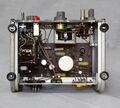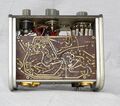1311-A: Difference between revisions
Jump to navigation
Jump to search
No edit summary |
No edit summary |
||
| Line 13: | Line 13: | ||
{{Catalog History}} | {{Catalog History}} | ||
}} | }} | ||
The {{Title|General Radio 1311-A Audio Oscillator}} was introduced in {{Catalog R}} and remained available through {{Catalog 1978}}. | The {{Title|General Radio 1311-A Audio Oscillator}}, a transistorized Wien-bridge audio oscillator with transformer output, was introduced in {{Catalog R}} and remained available through {{Catalog 1978}}. | ||
The switched output frequencies correspond to commonly used bridge generator frequencies. A delta frequency control is available on the front panel to fine-tune the frequency. Although designed as a bridge oscillator, the 1311-A is also well suited for audio testing, given its low hum and distortion levels. | |||
As a bridge oscillator, it is part of the [[1660-A]] Inductance and [[1620-A]] Capacitance Measurement Systems. | |||
==Specifications== | ==Specifications== | ||
* '''Frequency Range:''' 11 fixed frequencies – 50, 60, 100, 120, 200, 400, | * '''Frequency Range:''' 11 fixed frequencies selected by rotary switch – 50, 60, 100, 120, 200, 400, 500 Hz; 1, 2, 5, 10 kHz; ±2% vernier | ||
* '''Power Output:''' 1 W into matched load | * '''Power Output:''' 1 W into matched load; taps provide at least 0.5 W output into any resistive load between 80 mΩ and 8 kΩ | ||
* '''Output Voltage:''' Continuously adjustable from 0 to 1, 3, 10, 30, or 100 V, open circuit | * '''Output Voltage:''' Continuously adjustable from 0 to 1, 3, 10, 30, or 100 V, open circuit | ||
* '''Output Current:''' Continuously adjustable from 0 to 40, 130, 400, 1300, 4000 mA, short circuit (approx) | * '''Output Current:''' Continuously adjustable from 0 to 40, 130, 400, 1300, 4000 mA, short circuit (approx) | ||
==Links== | ==Links== | ||
* [[Media:GR Exp 1311 08_1962.pdf|Experimenter describing Type 1311-A | * [[Media:GR Exp 1311 08_1962.pdf|Experimenter August 1962 describing Type 1311-A]] | ||
* [[Media:Electronics-1963-02-01 Ref GR 1311-A.pdf| R.G.Fulks, ''Novel feedback loop stabilizes audio oscillator''; Electronics Vol.36 No.5, 1 Feb 1963. | * [[Media:Electronics-1963-02-01 Ref GR 1311-A.pdf| R.G.Fulks, ''Novel feedback loop stabilizes audio oscillator''; Electronics Vol.36 No.5, 1 Feb 1963. | ||
]] | ]] | ||
Revision as of 02:40, 28 April 2024
The General Radio 1311-A Audio Oscillator, a transistorized Wien-bridge audio oscillator with transformer output, was introduced in Catalog R (1963) and remained available through Catalog 1978.
The switched output frequencies correspond to commonly used bridge generator frequencies. A delta frequency control is available on the front panel to fine-tune the frequency. Although designed as a bridge oscillator, the 1311-A is also well suited for audio testing, given its low hum and distortion levels.
As a bridge oscillator, it is part of the 1660-A Inductance and 1620-A Capacitance Measurement Systems.
Specifications
- Frequency Range: 11 fixed frequencies selected by rotary switch – 50, 60, 100, 120, 200, 400, 500 Hz; 1, 2, 5, 10 kHz; ±2% vernier
- Power Output: 1 W into matched load; taps provide at least 0.5 W output into any resistive load between 80 mΩ and 8 kΩ
- Output Voltage: Continuously adjustable from 0 to 1, 3, 10, 30, or 100 V, open circuit
- Output Current: Continuously adjustable from 0 to 40, 130, 400, 1300, 4000 mA, short circuit (approx)
Links
- Experimenter August 1962 describing Type 1311-A
- R.G.Fulks, Novel feedback loop stabilizes audio oscillator; Electronics Vol.36 No.5, 1 Feb 1963.







